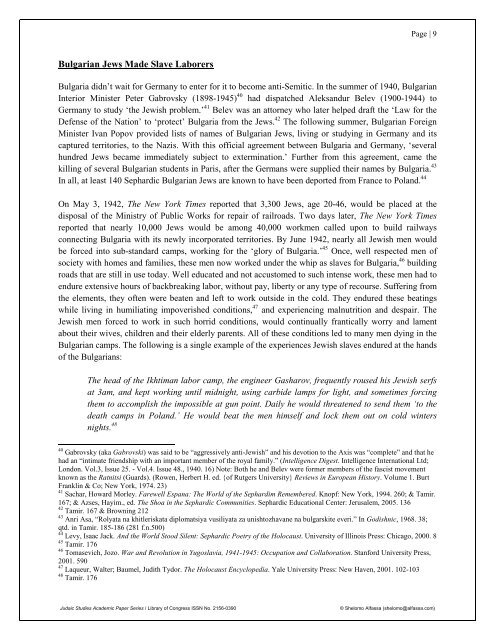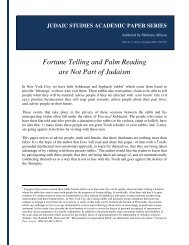Clarifying 70 Years of Whitewashing and ... - Shelomo Alfassa
Clarifying 70 Years of Whitewashing and ... - Shelomo Alfassa
Clarifying 70 Years of Whitewashing and ... - Shelomo Alfassa
Create successful ePaper yourself
Turn your PDF publications into a flip-book with our unique Google optimized e-Paper software.
Bulgarian Jews Made Slave Laborers<br />
Page | 9<br />
Bulgaria didn’t wait for Germany to enter for it to become anti-Semitic. In the summer <strong>of</strong> 1940, Bulgarian<br />
Interior Minister Peter Gabrovsky (1898-1945) 40 had dispatched Aleks<strong>and</strong>ur Belev (1900-1944) to<br />
Germany to study ‘the Jewish problem.’ 41 Belev was an attorney who later helped draft the ‘Law for the<br />
Defense <strong>of</strong> the Nation’ to ‘protect’ Bulgaria from the Jews. 42 The following summer, Bulgarian Foreign<br />
Minister Ivan Popov provided lists <strong>of</strong> names <strong>of</strong> Bulgarian Jews, living or studying in Germany <strong>and</strong> its<br />
captured territories, to the Nazis. With this <strong>of</strong>ficial agreement between Bulgaria <strong>and</strong> Germany, ‘several<br />
hundred Jews became immediately subject to extermination.’ Further from this agreement, came the<br />
killing <strong>of</strong> several Bulgarian students in Paris, after the Germans were supplied their names by Bulgaria. 43<br />
In all, at least 140 Sephardic Bulgarian Jews are known to have been deported from France to Pol<strong>and</strong>. 44<br />
On May 3, 1942, The New York Times reported that 3,300 Jews, age 20-46, would be placed at the<br />
disposal <strong>of</strong> the Ministry <strong>of</strong> Public Works for repair <strong>of</strong> railroads. Two days later, The New York Times<br />
reported that nearly 10,000 Jews would be among 40,000 workmen called upon to build railways<br />
connecting Bulgaria with its newly incorporated territories. By June 1942, nearly all Jewish men would<br />
be forced into sub-st<strong>and</strong>ard camps, working for the ‘glory <strong>of</strong> Bulgaria.’ 45 Once, well respected men <strong>of</strong><br />
society with homes <strong>and</strong> families, these men now worked under the whip as slaves for Bulgaria, 46 building<br />
roads that are still in use today. Well educated <strong>and</strong> not accustomed to such intense work, these men had to<br />
endure extensive hours <strong>of</strong> backbreaking labor, without pay, liberty or any type <strong>of</strong> recourse. Suffering from<br />
the elements, they <strong>of</strong>ten were beaten <strong>and</strong> left to work outside in the cold. They endured these beatings<br />
while living in humiliating impoverished conditions, 47 <strong>and</strong> experiencing malnutrition <strong>and</strong> despair. The<br />
Jewish men forced to work in such horrid conditions, would continually frantically worry <strong>and</strong> lament<br />
about their wives, children <strong>and</strong> their elderly parents. All <strong>of</strong> these conditions led to many men dying in the<br />
Bulgarian camps. The following is a single example <strong>of</strong> the experiences Jewish slaves endured at the h<strong>and</strong>s<br />
<strong>of</strong> the Bulgarians:<br />
The head <strong>of</strong> the Ikhtiman labor camp, the engineer Gasharov, frequently roused his Jewish serfs<br />
at 3am, <strong>and</strong> kept working until midnight, using carbide lamps for light, <strong>and</strong> sometimes forcing<br />
them to accomplish the impossible at gun point. Daily he would threatened to send them ‘to the<br />
death camps in Pol<strong>and</strong>.’ He would beat the men himself <strong>and</strong> lock them out on cold winters<br />
nights. 48<br />
40<br />
Gabrovsky (aka Gabrovski) was said to be “aggressively anti-Jewish” <strong>and</strong> his devotion to the Axis was “complete” <strong>and</strong> that he<br />
had an “intimate friendship with an important member <strong>of</strong> the royal family.” (Intelligence Digest. Intelligence International Ltd;<br />
London. Vol.3, Issue 25. - Vol.4. Issue 48., 1940. 16) Note: Both he <strong>and</strong> Belev were former members <strong>of</strong> the fascist movement<br />
known as the Ratnitsi (Guards). (Rowen, Herbert H. ed. {<strong>of</strong> Rutgers University} Reviews in European History. Volume 1. Burt<br />
Franklin & Co; New York, 1974. 23)<br />
41<br />
Sachar, Howard Morley. Farewell Espana: The World <strong>of</strong> the Sephardim Remembered. Knopf: New York, 1994. 260; & Tamir.<br />
167; & Azses, Hayim., ed. The Shoa in the Sephardic Communities. Sephardic Educational Center: Jerusalem, 2005. 136<br />
42<br />
Tamir. 167 & Browning 212<br />
43<br />
Anri Asa, “Rolyata na khitleriskata diplomatsiya vusiliyata za unishtozhavane na bulgarskite everi.” In Godishnic, 1968. 38;<br />
qtd. in Tamir. 185-186 (281 f.n.500)<br />
44<br />
Levy, Isaac Jack. And the World Stood Silent: Sephardic Poetry <strong>of</strong> the Holocaust. University <strong>of</strong> Illinois Press: Chicago, 2000. 8<br />
45 Tamir. 176<br />
46 Tomasevich, Jozo. War <strong>and</strong> Revolution in Yugoslavia, 1941-1945: Occupation <strong>and</strong> Collaboration. Stanford University Press,<br />
2001. 590<br />
47 Laqueur, Walter; Baumel, Judith Tydor. The Holocaust Encyclopedia. Yale University Press: New Haven, 2001. 102-103<br />
48 Tamir. 176<br />
Judaic Studies Academic Paper Series / Library <strong>of</strong> Congress ISSN No. 2156-0390 © <strong>Shelomo</strong> <strong>Alfassa</strong> (shelomo@alfassa.com)



